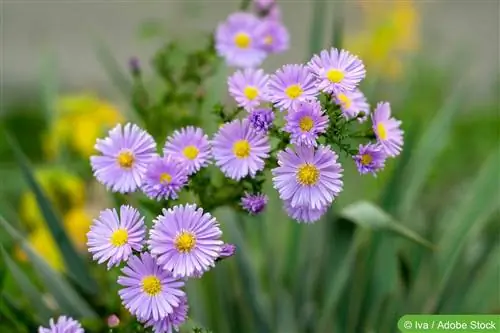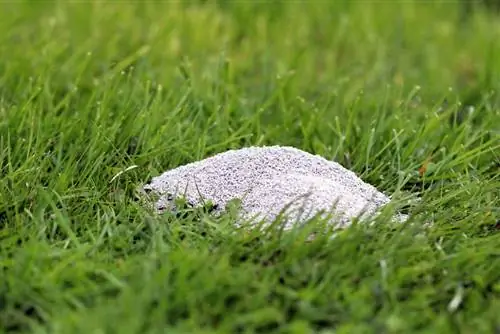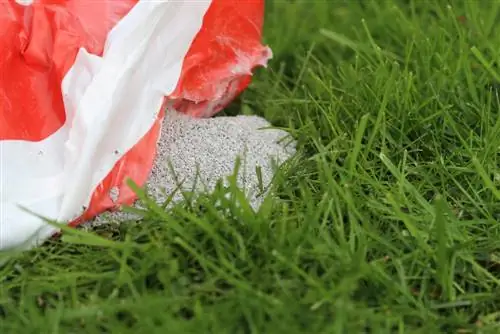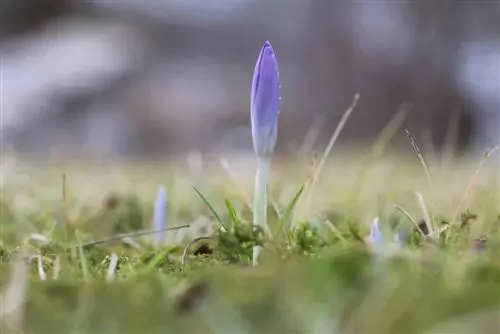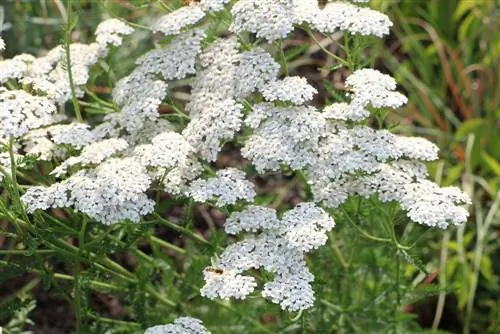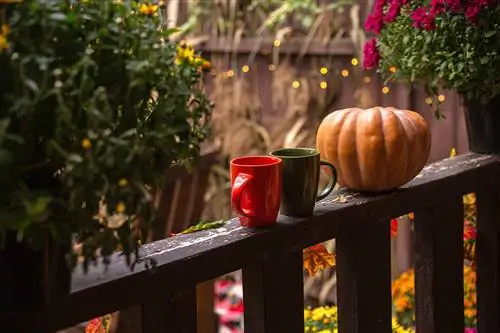- Author admin [email protected].
- Public 2023-12-17 03:39.
- Last modified 2025-01-24 12:45.
Autumn asters are the plants' last colorful greeting of the year. They only start to bloom in late summer and then form a colorful sea of flowers by October that shines from afar. Autumn asters are ideal for perennial beds and create colorful highlights in autumn in arrangements with lots of grasses.
variety selection
There are many types of asters and the autumn asters are only one of the subgroups. They are in turn divided into annual and perennial varieties. Annual varieties are usually available in stores in late summer and are significantly smaller than their perennial relatives. However, annual varieties are also available in bright colors, but die back after flowering in the fall. The color spectrum of perennial varieties ranges from delicate white to strong purple to a bright pink that shines from afar. Perennial autumn asters differ not only in color, but also in the shape of the flowers. There are asters with wide open or semi-double flowers - but the individual species do not differ in terms of care.
Tip:
Autumn asters are not only a visual delight for humans, they are one of the last sources of food for insects such as bees in autumn.
Location
The location should be sunny. Locations with morning or evening sun are best; autumn asters have very poor tolerance to the blazing midday sun. Too much sun promotes early flowering, which can wear out the plant in the long term. If there is no other option, autumn asters can also be planted in partial shade, but then you have to expect that they will remain lower and produce fewer flowers. Wild forms such as the blue aster or the white forest aster should be planted in partially shaded locations.
Floor
Autumn asters feel most comfortable in loose and nutrient-rich soil. If the soil is too dense, it can be loosened up a little, for example by incorporating sand. As part of the soil preparation, incorporate organic fertilizer in the form of compost or horn shavings into the soil and create an optimal basis for planting.
Care
pruning
Autumn asters are very undemanding when it comes to care. Pruning close to the ground is done in spring, as the perennial is usually not cut in autumn.
Pouring
Autumn asters need constantly moist soil so that they can produce many flowers until autumn. Immediately before flowering, the autumn asters should be watered more intensively, but no waterlogging should occur. Particularly in the dry summer months, care must be taken to ensure that the autumn asters are watered regularly.
Fertilize
The autumn asters should be supplied with additional fertilizer, for example in liquid form, at least twice a year. In spring, fresh compost or other long-term organic fertilizer such as horn shavings can also be worked into the soil around the perennial.
Cut
Tip non-stable varieties when they have reached about a third of their total height. This promotes more compact growth and makes the perennial more stable, which means that additional support measures can be dispensed with.
Tip:
If the withered first flowers are cut off early, the autumn aster is stimulated to produce new flowers, which can significantly extend the flowering period.
Propagation
Sowing: Autumn asters can be sown directly outdoors in early spring. The seeds begin to germinate at temperatures around 20°C - but at least a year passes before the autumn aster blooms for the first time.
Division
Propagation is easier by dividing the rhizomes. The best time for division is spring. Remove the clumps from the ground with a spade and divide them with a large knife. The site should again be prepared with organic long-term fertilizer such as horn shavings.
Tip:
Propagation by division simultaneously rejuvenates the plants. The perennial should therefore be divided every four years.
Wintering
You shouldn't bother removing the old inflorescences of the perennial in late autumn, as they help the plant overwinter. They provide natural frost protection, because if a frost occurs immediately after the plants have been pruned, this can cause long-term damage to the plant and even lead to its complete death. If the perennial is cut in autumn, it should immediately be covered with brushwood so that the frost cannot damage it.
Diseases and pests
Autumn asters are very robust plants that are hardly affected by pests and diseases, provided they have a good location.
Voles
The autumn asters can be dangerous from voles, which like to nibble on the roots unless they find something more worthwhile in the garden.
Mildew
If the growth is too dense, powdery mildew can occasionally form. The plants should then be rejuvenated next year and planted in a more spacious location. Infected plant parts should also be cut off and disposed of.
Aster wilt
A typical problem with autumn asters, however, is the so-called aster wilt. In the early stages, leaves hang limply, as if the plant had too little water. Increased watering doesn't help, because in the next stage the lower leaves begin to die off. The aster wilt is not threatening. A fungus is responsible for this damage and is difficult to combat.
To prevent this problem from occurring in the first place, the location for autumn asters should be changed every few years. If the drooping leaves don't bother you, the bare spots can be covered with decorative ornamental grasses in the foreground.
Frequently asked questions
Are autumn asters also suitable as cut flowers?
Autumn stars are ideal as cut flowers and are the last greeting in summer. Depending on the variety, autumn asters can reach up to two meters. The advantage, however, is that the autumn asters do not have to be shortened to the ground after they have been cut for a vase, because in the best case scenario they will sprout new shoots with flowers on the sides.
Can autumn asters be planted in pots?
Autumn asters are suitable for cultivation in pots, although care must be taken to ensure that the container is large and heavy. Otherwise, due to the heights that the plants can reach, the pot may simply tip over due to its top-heavy nature. The pot, like the location in the garden, should be filled with a nutrient-rich, permeable substrate. For overwintering, the pots should be tied up well and covered on top with brushwood so that the plant is not damaged by frost.
What you should know about autumn asters in brief
The rough-leaf aster, botanical name Aster novae-angliae, is an autumn aster. Her name comes from Greek and means star. The name refers to the star-shaped flowers of most species.
- The Raublattaster is also known under the name Alma Pötschke. It is one of the brightest asters among the rough-leaved asters.
- It has a strong red color and provides a welcome splash of color in any garden in autumn.
- The Aster novae-angliae is considered a very robust and upright growing type of aster.
- It feels most comfortable in a sunny location and in slightly moist and humus-rich garden soil.
- The rough leaf asters grow best when the location is changed every three to four years.
- Autumn asters and therefore also the Aster novae-angliae are planted in spring.
Cutting
If you want to have well-branched rough leaf asters, you should cut back the perennial bushes by a third in June. This means they can grow much more branched later. It is also very helpful to tie individual, tall autumn asters to poles or special perennial holders. This prevents the plants from breaking.
Soil requirements
- In order to develop splendidly, the rough leaf aster needs, as mentioned, slightly moist and humus-rich soil.
- In this context, experts speak of fresh soil, but this has nothing to do with the age of the earth.
- This refers to soils that remain predominantly moist in the area of the roots.
- Sandy soil doesn't have the ability to hold water very well.
- The ability to store nutrients and release them to the roots when needed is also not the case with sandy soil.
- Autumn asters like the rough-leaved asters but love well-fertilized soil in a sunny location.
- With sufficient moisture and nutrients, they grow so luxuriantly that experts recommend cutting some of the perennials by a third in June.
- These parts then flower later, so that the entire flowering period of the perennial is extended.
- But even if the soil can store moisture well, you should water the rough leaf aster very well in summer.
- The aster needs a lot of moisture, especially in the dry late summer period.

